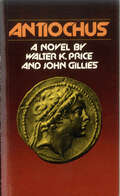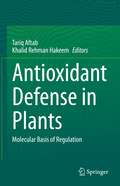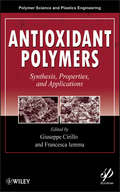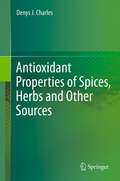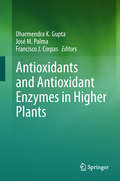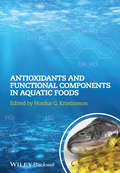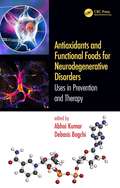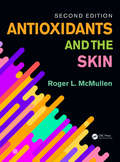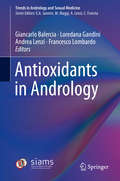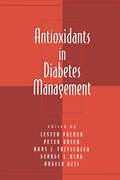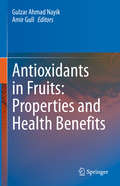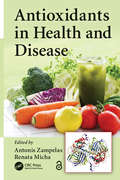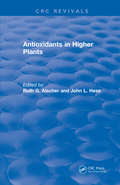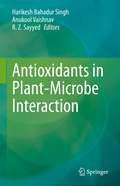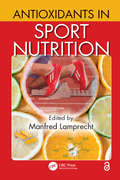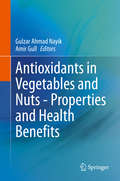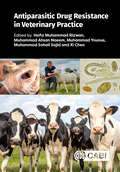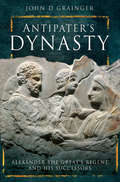- Table View
- List View
Antiochus: A Novel
by John Gillies Walter PriceHe was one of the most notorious persecutors of the Jews who ever lived. He defiled the Temple of God, killed religious zealots, and became the archetype of the Antichrist.The Greek monarch, King Antiochus IV Epiphanes, ruled the ancient Seleucid Empire 2200 years ago. The authors have written the story of his reign and find an extremely revealing relationship between this mysterious personality and certain events that the Bible indicates are yet to come to pass.An important evil figure in Bible prophecy comes to life in Antiochus.
Antiochus: A Novel
by John Gillies Walter PriceHe was one of the most notorious persecutors of the Jews who ever lived. He defiled the Temple of God, killed religious zealots, and became the archetype of the Antichrist.The Greek monarch, King Antiochus IV Epiphanes, ruled the ancient Seleucid Empire 2200 years ago. The authors have written the story of his reign and find an extremely revealing relationship between this mysterious personality and certain events that the Bible indicates are yet to come to pass.An important evil figure in Bible prophecy comes to life in Antiochus.
Antioxidant Defense in Plants: Molecular Basis of Regulation
by Khalid Rehman Hakeem Tariq AftabThis edited book highlights the molecular basis of various enzymatic and non-enzymatic antioxidants, defense mechanisms and adaptation strategies employed by plants to avoid the stressful conditions. Special focus is given to gene expression, omics and other latest technologies such as CRISPR-Cas mediated genome editing applications for defense related studies in plants. Environmental stresses such as drought, salinity or floods etc. induce the generation of reactive oxygen species (ROS) which causes severe damage to cell membrane integrity by accelerating lipid peroxidation. To counteract the detrimental effect of ROS, plants are inherited with an intricate and vibrant antioxidant defense system, comprised of enzymatic (catalase, peroxidase, superoxide dismutase, glutathione reductase, glutathione S-transferase, guaiacol peroxidase, monodehydroascorbate reductase, dehydroascorbate reductase etc.), and non-enzymatic (glutathione, ascorbate, α-tocopherol, carotenoids, flavonoids etc.) antioxidants, which scavenge and/or reduce excess ROS and improve plant tolerance to various stresses. Stress tolerance in most crop plants is positively correlated with an efficient antioxidant system. Therefore, studying the efficiency of antioxidant defense systems in plants is necessary for facilitating the plant’s nature of adaptation against challenging environments. This book is of interest to teachers, researchers and academic experts. Also, the book serves as additional reading material for undergraduate and graduate students of biotechnology and molecular biology of plants.
Antioxidant Nutraceuticals: Preventive and Healthcare Applications (Nutraceuticals)
by Chuanhai Cao Sarvadaman Pathak Kiran PatilThis book addresses various clinical and sub clinical applications of antioxidant nutraceuticals, with a primary focus on preventive use for general wellness, common ailments, and such chronic illnesses as cancer and neurological applications. This unique book captures the applications of natural antioxidants, which have been used for thousands of years in Traditional Chinese Medicine and Ayurvedic Medicine as well as modern nutraceuticals formulations. It covers antioxidant applications in clinical scenarios including the historical perspective, basic antioxidant properties and applications, anti-inflammatory properties, and antioxidant applications in a variety of clinical conditions.
Antioxidant Polymers
by Giuseppe Cirilo Francesca IemmaAntioxidant Polymers is an exhaustive overview of the recent developments in the field of polymeric materials showing antioxidant properties. This research area has grown rapidly in the last decade because antioxidant polymers have wide industry applications ranging from materials science to biomedical, pharmaceuticals and cosmetics.
Antioxidant Properties of Spices, Herbs and Other Sources
by Denys J. CharlesThe scientific world and modern society today is experiencing the dawning of an era of herbal medicine. Extensive research has shown that aromatic plants are important anti-inflammatory, antioxidant, anti aging and immune boosting delectable foods, with the magic and miracle to boost our immune system providing us with extended and an improved quality of life. Apart from making bland recipes into welcoming or interesting victories, herbs and spices have stirred the minds of the research community to look deeper into its active components from a functional perspective. It is essential to present the scientific and medicinal aspect of herbs and spices together with the analysis of constituents, its medicinal application, toxicology and its physiological effects. Herbs and spices with high levels of antioxidants are in great demand as they tend to promote health and prevent diseases naturally assuring increased safety and reliability for consumers. Herbs and spices are not only known for taste and flavor, but today research has opened up a new realm in which the antioxidant properties of these aromatic plants provide preservation for foods and health benefits for consumers who look forward to concrete scientific research to guide them further and explore herbal medicine. The aim of this book is to create awareness in society about the reliability of medicinal properties of certain herbs and spices through scientific and scholarly research.
Antioxidant Status, Diet, Nutrition, and Health (Contemporary Food Science Ser. #9)
by Andreas M. PapasThis is the first book to integrate the biological, nutritional, and health aspects of antioxidant status. Fifty contributors integrate and transfer the knowledge of free radicals and antioxidants from the test tube to the laboratory of the biologist, clinical nutritionist, and medical researcher, as well as to the office of the dietician, nutritionist, and physician. Topics examined include factors affecting and methods for evaluating antioxidant status in humans; effect of diet and physiological stage (infancy, aging, exercise, alcoholism, HIV infection, etc.) on antioxidant status; and the role of antioxidant status in nutrition, health, and disease.
Antioxidants and Antioxidant Enzymes in Higher Plants
by Francisco J. Corpas Dharmendra K. Gupta José M. PalmaThis book provides an overview of antioxidants and antioxidant enzymes and their role in the mechanisms of signaling and cellular tolerance under stress in plant systems. <P><P> Major reactive oxygen species (ROS)-scavenging/modulating enzymes include the superoxide dismutase (SOD) that dismutates O2 into H2O2, which is followed by the coordinated action of a set of enzymes including catalase (CAT), ascorbate peroxidase (APX), glutathione peroxidase (GPX) and peroxiredoxins (Prx) that remove H2O2. In addition to the ROS scavenging enzymes, a number of other enzymes are found in various subcellular compartments, which are involved in maintaining such redox homeostasis either by directly scavenging particular ROS and ROS-byproducts or by replenishing antioxidants. In that respect, these enzymes can be also considered antioxidants. Such enzymes include monodehydroascorbate reductase (MDAR), dehydroascorbate reductase (DHAR), glutathione reductase (GR), alternative oxidases (AOXs), peroxidases (PODs) and glutathione S-transferases (GSTs). Some non-enzymatic antioxidants, such as ascorbic acid (vitamin C), carotenes (provitamin A), tocopherols (vitamin E), and glutathione (GSH), work in concert with antioxidant enzymes to sustain an intracellular steady-state level of ROS that promotes plant growth, development, cell cycles and hormone signaling, and reinforces the responses to abiotic and biotic environmental stressors. <P> Offering a unique compilation of information on antioxidants and antioxidant enzymes, this is a valuable resource for advanced students and researchers working on plant biochemistry, physiology, biotechnology, and signaling in cell organelles, and those specializing in plant enzyme technology.
Antioxidants and Disease Prevention (Modern Nutrition)
by Harinder GarewalThe role of antioxidants and other nutritional agents in disease prevention is a widely discussed subject, attracting attention from professionals in all areas of medicine. This often-debated and rapidly evolving area of medicine could have important implications for how diseases are treated.
Antioxidants and Functional Components in Aquatic Foods
by Hordur G. KristinssonAntioxidants and Functional Components in Aquatic Foods compiles for the first time the past and present research done on pro and antioxidants in aquatic animals. The book addresses an area of extreme importance for aquatic foods, since lipid oxidation leads to such a large number of quality problems. Many of these problems are also seen in other muscle based foods, but are exaggerated in aquatic foods, so the book’s contents will be of great use and interest to other fields. Written by top researchers in the field, the book offers not only general overviews of lipid oxidation in aquatic foods and aquatic food pro and antioxidant systems, but also covers specifics and gives the latest information on the key pro and anti-oxidants derived from aquatic foods as well as some of the most recent and innovative means to control lipid oxidations in aquatic foods and food systems with fish oils. Coverage includes the latest research on the effects aquatic foods have on oxidative stress in the human body, an area of great interest recently. Additionally, a chapter is devoted to the latest techniques to measure antioxidative potential of aquatic foods, an area still in development and one very important to the antioxidant research community. Antioxidants and Functional Components in Aquatic Foods will be of great interest to the food science, medical, biochemical and pharmaceutical fields for professionals who deal with aquatic food products, muscle foods products (beef, pork, poultry etc), lipid oxidation, and pro-oxidant and antioxidant systems.
Antioxidants and Functional Foods for Neurodegenerative Disorders: Uses in Prevention and Therapy
by Debasis Bagchi Abhai KumarNeurodegenerative diseases, including Alzheimer’s and Parkinson’s disease, are a growing problem across the world’s aging population. Oxidative stress in the brain plays a central role in a common pathophysiology of these diseases. This book presents scientific research on the potential of antioxidant therapy in the prevention and treatment of neurodegenerative disorders.This book outlines the roles of oxidative stress and diabetes mellitus in neurodegeneration, describes the molecular mechanisms of neurodegenerative disorders including the roles of environmental pollutants and inflammatory responses, and explores mitochondrial dysfunction. It then describes the protective abilities of antioxidants – including vitamin D, tocotrienol and coenzyme Q10 – against neurodegeneration. The book demonstrates the therapeutic potential of ketogenic diets, and highlights the roles of medicinal plants, phytopharmaceuticals, traditional medicines and food nutrients in neuroprotection.Key Features: Explains damage caused by numerous neurodegenerative disorders and the possible protection offered by antioxidants and functional foods. Describes molecular mechanisms of neurodegeneration by oxidative stress, advancing age, diabetes and mitochondrial dysfunctions. Demonstrates protection offered by nutraceuticals, antioxidants, botanical extracts and functional foods. The book contains twenty-three chapters divided into six sections written by leading researchers. This book is essential reading for health professionals, dietitians, food and nutrition scientists and anyone wanting to improve their knowledge of etiology of neurodegenerative diseases.
Antioxidants and the Skin: Second Edition
by Roger L. McMullenThis highly illustrated book brings together many concepts related to skin care and antioxidant usage in one convenient text. The second edition now contains the latest antioxidants being marketed, and an analysis of risks and benefits associated.
Antioxidants in Andrology (Trends in Andrology and Sexual Medicine)
by Andrea Lenzi Giancarlo Balercia Loredana Gandini Francesco LombardoThis book focuses on the use of various molecules with antioxidant properties in the treatment of major male genital tract disorders, especially male infertility, erectile dysfunction, and accessory gland infection. The coverage also includes discussion of pathophysiology, the molecular basis of male infertility, and the rationale for use of antioxidants, with particular attention to coenzyme Q10 and carnitine. Oxidative stress occurs when the production of reactive oxygen species, including free radicals, exceeds the body's natural antioxidant defences, leading to cellular damage. Oxidative stress is present in about half of all infertile men, and reactive oxygen species can produce infertility both by damaging the sperm membrane, with consequences for sperm motility, and by altering the sperm DNA. There is consequently a clear rationale for the use of antioxidant treatments within andrology, and various in vitro and in vivo studies have indicated that many antioxidants indeed have beneficial impacts. In providing a detailed and up-to-date overview of the subject, this book will be of interest to both practitioners and researchers in andrology, endocrinology, and urology.
Antioxidants in Diabetes Management (Oxidative Stress and Disease)
by Lester Packer Peter Roser Hans J. Tritschler George L. King Anglo A221This volume summarizes current understanding of the pathogenic role of oxidative stress in the onset and progression of diabetes and its complications, and presents results of studies aimed at regulating oxidatively induced complications through the use of antioxidants. Examines the presence of impaired microcirculation, capillary hypoxia, and
Antioxidants in Fruits: Properties and Health Benefits
by Gulzar Ahmad Nayik Amir GullThis book provides a comprehensive review of the antioxidant value of widely consumed fruits. Each chapter covers the botanical description, nutritional & health properties of these popular fruits. Fruits are one of the most important indicators of dietary quality and offer protective effects against several chronic diseases such as cardiovascular diseases, obesity, and various types of cancer. In order to effectively promote fruit consumption, it is necessary to know and understand the components of fruits. In addition to underscoring the importance of fruit consumption’s effects on human diet, the book addresses the characterization of the chemical compounds that are responsible for the antioxidant proprieties of various fruits.Given its scope, the book will be of interest to graduate and post-graduate students, research scholars, academics, pomologists and agricultural scientists alike. Those working in various fruit processing industries and other horticultural departments will also find the comprehensive information relevant to their work.
Antioxidants in Health and Disease
by Antonis Zampelas and Renata MichaAntioxidant use in health promotion and disease prevention either through dietary intake or supplementation is controversial. This book reviews the latest evidence-based research in the area, principally through prospective cohort studies and randomized controlled trials. It assesses major dietary antioxidants and discusses their use in diseases such as cancer, diabetes, stroke, coronary heart disease, HIV/AIDS, and neurodegenerative and immune diseases. The use of antioxidants in health is also discussed along with common adverse effects associated with antioxidant use.
Antioxidants in Higher Plants (CRC Press Revivals)
by Ruth G. Alscher John L. HessAntioxidants in Higher Plants provides a unique blend of molecular and biochemical approaches to cover the state of the art in antioxidant function. The chemistry and protective potential of sulfhydryl and hydroxyl compounds are emphasized. Interesting perspectives are presented regarding the response of antioxidant metabolism to interactions among environmental pollutants, illumination, temperature, and water availability. The book also discusses how tools of molecular biology may further clarify antioxidant function and response to stress. Antioxidants in Higher Plants will be an excellent reference for plant physiologists, biochemists, molecular biologists, ecologists, and students.
Antioxidants in Plant-Microbe Interaction
by Harikesh Bahadur Singh R. Z. Sayyed Anukool VaishnavThis edited book is focused on antioxidant compounds and their biosynthesis, up-regulation, mechanism of action for selective bioactivity, targeted role and the advancement of their bioactive potential during plant-microbe interaction and other stress conditions. This book also emphasizes on the role of antioxidants in recruiting beneficial microbes in plant surroundings. Antioxidants have multiple biological roles in plants especially in the signalling pathway. These compounds are secondary metabolites produced besides the primary biosynthetic pathway and are associated with growth and development. Besides they also have special role to play during oxidative stress produced via abiotic stimulants or pathogen attack. This understanding of the biosynthesis, signaling and function of antioxidant compounds in plants during stress condition is helpful in restoring plant ecosystem productivity and improve plant responses to a wide range of stress conditions. This book is a useful compilation for researchers and academicians in botany, plant physiology, plant biochemistry and stress physiology. Also the book serves as reading material for undergraduate and graduate students of environmental sciences, agricultural sciences and other plant science courses.
Antioxidants in Sport Nutrition
by Manfred LamprechtAntioxidant use in sports is controversial due to existing evidence that it both supports and hurts athletic performance. This book presents information on antioxidants, specifically for athletes, and their roles in sports nutrition. It stresses how antioxidants affect exercise performance, health, and immunity. Chapters cover oxidative stress; basic nutrition for athletes; major dietary antioxidants; sports supplements; performance/adaptation to exercise; antioxidants role in health and immunity; reviews on vitamins C, E, beta-carotene, and minerals in sports nutrition; and roles polyphenols play in high-performance sport.
Antioxidants in Vegetables and Nuts - Properties and Health Benefits
by Gulzar Ahmad Nayik Amir GullThis book covers the nutritional and nutraceutical profiles of a wide range of popularly consumed vegetables and nuts. The first half of the book focuses on popular vegetables, and describes how higher vegetable consumption reduces the risk of diseases ranging from diabetes to osteoporosis, diseases of the gastrointestinal tract, cardiovascular diseases, autoimmune diseases and cancer. The book also includes an interesting section on the antioxidant potential of mushrooms. In turn, the second half discusses the nutritional value of various nuts. Nuts are nutrient-dense foods with complex matrices rich in unsaturated fats, high-quality protein, fiber, minerals, tocopherols, phytosterols and phenolics. The respective chapters illustrate how the consumption of nuts could ward off chronic diseases like hypertension, cancer, inflammation, oxidative stress, high blood pressure, coronary heart disease etc. In order to effectively promote vegetable and nut consumption, it is necessary to know and understand the nutritional and nutraceutical profiles of vegetables & nuts. Given its scope, the book will be of interest to students, researchers, food scientists, olericulturists, dietitians and agricultural scientists alike. Those working in the vegetable and nut processing industries, horticultural departments and other agricultural departments will also find the comprehensive information relevant to their work.
Antioxidants: How to live younger for longer by finding the right nutrients for you (Wellbeing Quick Guides)
by Liz EarleLiz Earle explains how these nutrients protect against cancer, heart disease and ageing and shows you how supplements and delicious recipes can bring them into your diet today.Bestselling beauty and wellbeing writer Liz Earle's fully revised and updated quick guide to antioxidants, including:- The science behind antioxidants and how they work- Their effect on ageing and age-related disorders- The dangers of free radicals and how to avoid them- Easy ways to add antioxidant nutrients into your diet- A sensible and safe guide to choosing your supplements
Antioxidants: Nature's Defense Against Disease
by Rakesh K. Sindhu Inderbir Singh M. Arockia BabuThis book provides a comprehensive exploration of the role antioxidants play in preventing and managing a variety of diseases and critically examines current research on the effects of nutritional antioxidants on specific disease states. Antioxidants: Nature’s Defense Against Disease investigates the complex relationship between oxidative stress and many health disorders, providing essential insights into the role of antioxidants in disease prevention. It investigates how oxidative stress, induced by an imbalance of free radicals and antioxidants in the body, leads to the development and progression of maladies ranging from cardiovascular disorders to neurological diseases. The book includes evidence-based ways for harnessing antioxidants from natural sources such as fruits, vegetables, and herbs to reduce the impact of oxidative damage and improve general health. The book presents the most recent scientific advances and clinical findings in antioxidant therapy. It is a comprehensive resource for healthcare professionals and researchers and covers everything from the molecular mechanisms that underpin oxidative stress to the protective benefits of antioxidants against chronic diseases. Through its interdisciplinary approach and practical insights, Antioxidants: Nature’s Defense Against Disease provides readers with the knowledge and tools they need to optimize antioxidant consumption, empowering them to control their health and lower their risk of severe diseases. Audience The core audiences for this book are nutritionists, dieticians, researchers, and graduate students in health sciences, and those interested in preventive healthcare, such as health, nutrition, fitness, and wellness enthusiasts, looking to deepen their understanding of implementing antioxidant strategies and improving lifestyle choices.
Antiparasitic Drug Resistance in Veterinary Practice
by Muhammad Usman Muhammad Imran Haider Abbas Dr Hafiz Muhammad Rizwan Dr Muhammad Sohail Sajid Dr Waqas Ahmad Muhammad Qasim Tooba Abbas Sumra Wajid Abbasi Zobia Afsheen Adeel Ahmad Zubaria Shahid Amin Farid Shokry Ataya Faiza Bano Ian Daniel Shamshad Fareed Zahid Fareed Muhammad Umar Farid Dalia Fouad Sadia Ghazanfar Adil Ijaz Ibadullah Jan Malcolm K. Jones Kashif Kamran Muhammad Abdullah Malik Zahid Manzoor Mahvish Maqbool Aiman Maqsood Manuela Marescotti Amir Munir Hizqeel Ahmed Muzaffar Shumaila Naz Nadia Nazish Fakhar Un Nisa HazratUllah Raheemi Haroon Rashid Muhammad Muneeb Rauf Mohsin Raza Aayesha Riaz Evelyn Saba Sadaf Faiz Abdullah Arif Saeed Muhammad Rizwan Saeed Rida Fatima Saeed Muhammad Nadeem Saleem Urfa Bin Tahir Rohit Tyagi Professor Muhammad Younus Muhammad Zeeshan Mian Mubashar Saleem M. Rajput Qaiser Akram Sibtain AhmadLack of clean water, inadequate sanitation, and insufficient infection prevention and control promote the spread of parasites. The discovery of antiparasitic drugs was considered a milestone in the veterinary and medical sciences, but their use has subsequently become limited due to the emergence of resistance. While plenty of attention has been given in human and animal health communities to the global threat of antimicrobial drug resistance, specific antiparasitic advice is less available. This book provides an in-depth view of the issue for parasitologists, pharmacologists and veterinary scientists. Specifically discussing antiparasitic drug resistance mechanisms and factors responsible for the problem, it covers: The physiological basis of parasitism; Resistance across protozoa, helminths, insects, mites and ticks; Molecular and phenotypic diagnostic methods; Practical strategies for mitigating resistance development. While it is clear that the veterinary field urgently requires the development of new antiparasitic drugs, of equal or even increased importance is the evaluation of alternative therapies and formulation of stringent policies to ensure appropriate drug use in veterinary practice. Highlighting the importance and development of resistance across different parasite groups, this book covers factors responsible for resistance development and advises strategies for effective stewardship and resistance mitigation.
Antipasti
by Joyce Goldstein Pablo Nobile Jeffrey MeiselWith growing numbers of restaurants specializing in "small plates," the antipasto is back in style. These little dishes of savory appetizers or small first courses (perfect cocktail food) whet the appetite, enticing the palate for the meal to comeand can even become the meal itself. In Antipasti, Joyce Goldstein reveals the history of antipasti and a host of very delicious recipes. What could be better suited to a La Dolce Vita-inspired event replete with sparkling Bellinis than sun-dried tomato-topped crostini, little panzerotti (pastries stuffed with Gruyre and ham), or prosciutto-wrapped shrimp? For easier fare, a snap to prepare, there is an entire chapter on Shop and Serve antipasti--molto tasty recipes that use high quality store-bought foods such as roasted peppers, olives, soft creamy cheeses, and crusty artisan breads that anyone can throw together for a last minute appetizer or elegant snack. Whether it's bite-sized pieces of Parmigiano-Reggiano cheese drizzled with balsamic vinegar to serve before a dinner party or a more substantial first course of roasted duck breast salad, Antipasti welcomes everyone to the table.
Antipater's Dynasty: Alexander the Great's Regent and his Successors
by John D. Grainger&“A compelling review of Antipater and his family . . . A gripping story of a real game of thrones&” from the author of the Seleukid Empire trilogy (Firetrench). Antipater was a key figure in the rise of Macedon under Philip II and instrumental in the succession of Alexander III (the Great). Alexander entrusted Antipater with ruling Macedon in his long absence and he defeated the Spartans in 331 BC. After Alexander&’s death he crushed a Greek uprising and became regent of the co-kings, Alexander&’s mentally impaired half-brother (Philip III Arrhideus) and infant son (Alexander IV). He brokered a settlement between the contending Successors but died in 319 BC, having first appointed Polyperchon to succeed as regent in preference to his own sons. Antipater&’s eldest son Cassander later became regent of Macedon but eventually had Alexander IV killed and made himself king. Three of his sons in turn briefly succeeded him but could not retain the throne. Antipater&’s female heirs are shown to be just as important, both as pawns and surprisingly independent players in this Macedonian game of thrones. The saga ends with the failed bid by Nikaia, the widow of Antipater&’s great grandson Alexander of Corinth, to become independent ruler of Macedon. &“A great book by a great author on one of the most important of the Diadochi.&” —A Wargamers Needful Things
